GUTACHTEN von Dr. ARSEN FARADZHEV (2006) 
In Ermangelung von Interesse an den gefundenen Objekten seitens professionell ausgebildeter Fachleute im Lande, war durch den Erwerb und der Mitgliedschaft des australischen Vereins für ROCK ART RESEARCH ( RAR ) das Magazin unter 2 maliger jährlichen Ausgabe durch seinen Editor ROBERT BEDNARIK, von Interesse für mich. In seiner Ausgabe des Heftes AUSTRALIAN ROCK ART RESEARCH ASSOCIATION (AURA), an international Federation of Rock Art Organizations (IFRAO), Volume 22, Number 2 von November 2005, wurde ich auf die Aufsätze von Dr. Arsen FARADZHEV aufmerksam gemacht.
Transl.: Missing the interest in my finds of any professional educated Experts of my country, I felt inspired by the ROCK ART RESEARCH ( RAR ) Magazine. Twice during the year its editor ROBERT BEDNARIK issued" References of relevant interesting papers. The issue of November 2005 of (AURA) AUSTRALIAN ROCK ART RESEARCH ASSOCIATION, Volume 22, pointed at three papers of interest, written by a Moscow researcher Dr. Arsen FARADZHEV.
Up dated NEWS from Arsen Faradzhev e-mail from 28.10.2011
Dieser Forscher hatte dort in BOOKHOUSE Moscow und im Science-Publicistic Magazine No. 4, insgesamt 3 Aufsätze geschrieben, die allein schon durch die Überschriften mein Interesse erwekten./ This researcher published in BOOKHOUSE, Moscow and in a Science Publicistic Magazine No. 4, three Articles, which have drawn my attention simply by the headlines of this essayist for example: "Creative consciousness in the Stone Age."
Zum Beispiel: "Wie hat die Kunst sich entwickelt? Der Beginn einer nutzlosen Aktivität." Dieser Artikel erschien in einem anderen Buch mit Titel "Zivilisations-Geheimnisse". Kürzlich bekam ich seinen Aufsatz "PALAEOART ON INDIAN TERRITORY" in russischer Sprache abgefaßt. Die Bookhouse - Bücher jedoch sind ein wahrer Bilder-Schatz, die alle Artikel mit außergewöhnlich schönen Fotos umrahmen. Eines, mit dem Buch-Titel "STONE" , kann ich nun mein Eigen nennen, mit einer Widmung vom Forscher und Artist zugleich. Siehe dazu das nächste Foto: "PETROGLYPHIC CREATIONS"; den Text werde ich übersetzen lassen, denn Eigeninitiative war bereits genommen, IHN HIER BEI MIR PERSOENLICH ZU TREFFEN, um über seine Arbeit zu sprechen und dabei dann die meine zu beurteilen. So waren die ersten 10 Tage seines Besuches vom Kennenlernen des Steinmaterials geprägt, mein Zimmer war mit Artefakten überfüllt,( siehe Foto), doch macht er seine eigene Auswahl und hinterließ mir darüber eine EXPERTISE, welches ich dem interessierten Leser auf dieser Seite und auf dem KAPITEL IX, getrennt vorstelle.
Transl.: ....For example: " How did art arise? The origins of useless activity" but printed in another book with the title "Secrets of Civilisations" but not in my possession so far. In recent time I did receive his essay "PALAEOART ON INDIAN TERRITORY" in the russian language version as well. The Bookhouse-prints from Moscow are presenting their articles in addition with beautiful photos. The Book title called STONE(KaMeHb) , I can call my own now , signed by the researcher for me. See picture below. I will have this text translated some day but meanwhile, I rather took the chance to get to know him in PERSON, to speak to him about the subject matter, and to evaluate my finds. On his first 10 day`s visit here, there was much to be "presented" to him, getting a feeling for my sampled material. My room was "packed" with artifacts, but he made his own selection. About this he wrote an EXPERTISE which I publish here for those who are interested in details.
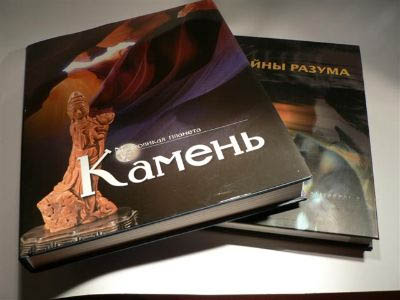
The Title of the book is called "STONE . A many sided planet." It shows what human hands made out of "stone" of for instance BERSTEIN, but much more. It is a" picture treasure" in itself for me. ARSEN FARADZHEV shows what people did to " open air rock surfaces" in former times on the pages 256-267.(Petroglyphic creations).Transl.: Dieser Buchtitel nennt sich "STEINE"; EIN VIELSCHICHTIGER PLANET. Dabei ist dieses Buch ein wahrer Bilder-Schatz schon für sich selbst und zeigt auf, wie sich zum Beispiel Bernstein unter der Hand des Menschen "verwandelt". Aber Arsen FARADZHEV zeigt , wie sich schon in viel früheren Zeiten auf offenen Felshängen die künstlerische Seite des Menschen offenbarte. Auf den Seiten 256-267 (siehe Foto unten) sieht man Petroglyphen entstehen, sein Aufsatztitel "Petroglyphic creations".
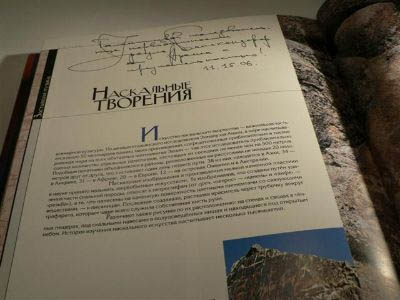
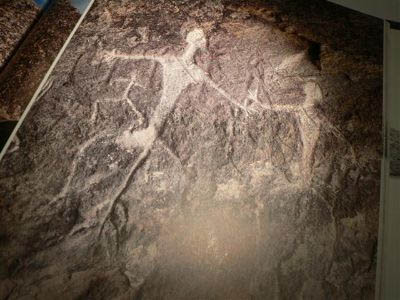
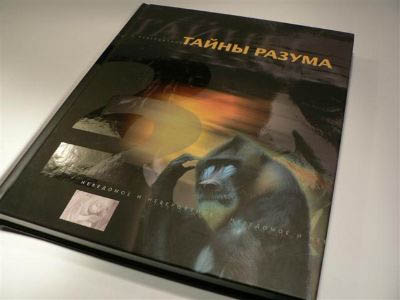
The book title/Buchtitel: "The mind secrets", he signed for me the pages 160-170
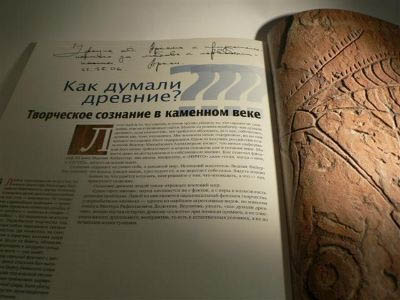
"In co-operation with nature. Creative consciousness in the Stone Age" is here the subject matter.
Leider ist mir die russische Sprache nicht geläufig, zu gern hätte ich hier gelesen, was Arsen Farad. selbst dazu niedergeschrieben hat, denn zu diesem Thema hatte auch ich mir mit den Jahren so meine eigenen Gedanken gemacht. Dabei hat mich auch der Stein selbst immer inspiriert und fungierte als Informationsträger, erlaubt mir aber gleichzeitig, keine eigene Kreativität durch Veränderung am so entstandenen" Bilderkatalog der Steinzeit". Menschen, die schon vor mir den Stein "erkannten" und ihn manches Mal in seine heutige Form nun " verbannten", haben viele Steine vielleicht für andere Zwecke umfunktioniert. Dieser Gedanke hatte sich immer mehr verfestigt, wenn der Steinträger den Eindruck einer Multifunktionalität erweckte, wie zum Beispiel der "Logo-Stein" dieser Webseite. Sein Bildniss ist beeindruckend, aber nicht herausragend, denn seine Grundform ist eine wohl übliche Formgebung, wie es sich durch die Erforschung des Paläolithikums, nun ergibt. Auf dem nachfolgenden Foto zeige ich seine Rückseitenansicht und stelle das Bildnis eines Menschen dabei auf den Kopf.
Translation: Sorry, that I do not speak and read the Russian language, I would have loved to read the text from Arsen Faradzhev. During the years of my own research and rescue attempt in the gravel pit, was the "stone" always an inspirator via form and other signals, he was an information recorder at the same time, who did not allow me to "re-use" him in any personal creativity attempts, however signalizing a " multi functionalism" for instance, like my "Logo-Head" of this website Chapter 1 "suggests". On the next photo, I do present the backside of this impressive human face, by turning the object up side down, an alltogether different impression is obvious. Resembling thus a well accepted "shape" of so called "handaxes", found during research of the old and middle palaeolithicum.
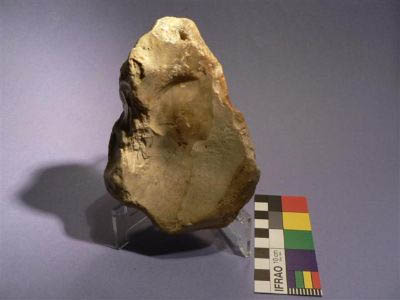
Backside view of the "double image" or picture # 1 in the following text . Rückseiten-Ansicht des Bilder-steines von Seite 1 dieser Web-seite. Vergleiche dazu den folgenden Text.
Diverse Formen typologisch als "Werkzeugformen" in der paläolithischen Forschung definiert und akzeptiert. Several shapes typologically identified as tools and accepted in pal. research.
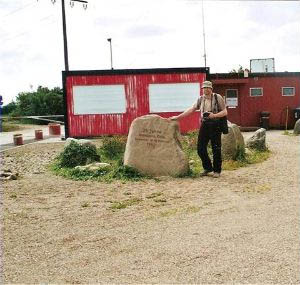 Month of June 2006
Month of June 2006
Besuch/ visit in Groß-Pampau vom Experten aus Moskau, Russland ARSEN FARADZHEV, PhD and Official representative of Russian Federation at International Federation of Rock Art Organization (IFRAO).
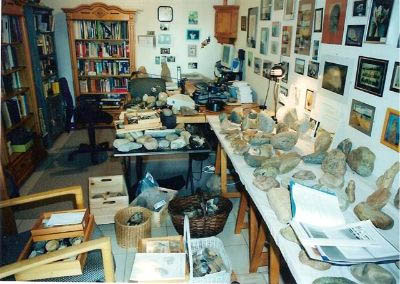 June 2006
June 2006
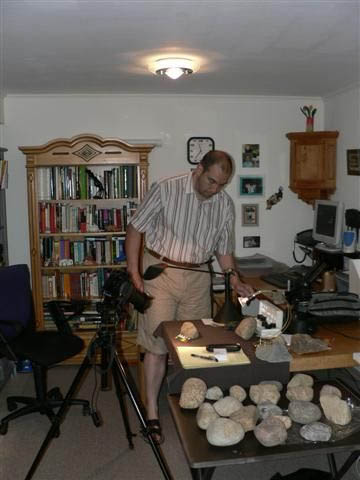 Month of June 2006
Month of June 2006
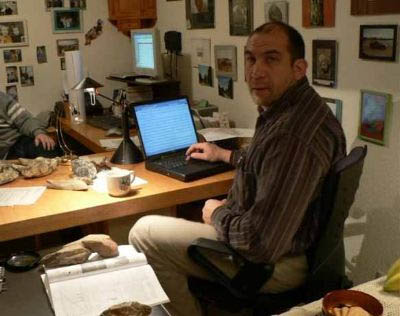 November 2006
November 2006
E X P E R T I S E by
Arsen Faradzhev, PhD, from the MOSCOW STATE UNIVERSITY; DEPT. of Archaeology
PALAEOART AND SELECTION
Human life is a process of selection. Everybody knows this for sure from his or her daily life experience. It is such a common act that people are at times no longer aware of this act. Nevertheless, humans as one of the Hominid species have to “select” every single moment simply to stay alive.
The Palaeoart creation is also a kind of activity selection. The Palaeoart images alone include several processes of selection: first, there is the idea of the image, resulting there after is the material selection, including here the selection of some kind of manipulations in order to create the artificial image, according to the author’s plan. For instance the selection of the place needs to be considered, or more so the type of rock surface, depending on the plan, for either cave or open air rock art, as well as the selection of an appropriate natural object, to create some portable artifacts only.
However, the act of Palaeoart creation is in itself already a unique exception from all other possible kinds of human selections. It may well be compared or described as an hypothetical prehistorical ocean where amongst the different routine artifacts, few drops are spared on Palaeoart images only
Now, the Palaeoart research seems to be also a selection process. It could be scientific or non-scientific but never at the same time. (Farajev 1995b; 1999b). The prehistorical researcher either coming from some Institute or being a private collector selects the images, site, the approach, methods, and evidences and so on. Moreover, for each, it remains an individual selection, often governed by a person private judgment applied towards creation.
But in either way, wether it is the selection of images in the field, or the judgment of somebody’s collection of artifacts, the Palaeoart images themselves are evidence of a very special creative “selection” process, with the most expressive, extremely sensitive and immediate influential effect on human life. Therefore, Palaeoart images are our most precious and authentic historical documents shared by all involved.Palaeoart research activity reflects also a very personal feeling towards art. Again, this is the same for everyone either being an institutional or private researcher and a key point at the same time. It is similar to musical “feeling” and understanding of tunes not always heard with a “perfect ear”. Regardless, the researchers do have to present their “scientific evidences” of their investigation in a proper way and such can be expeceted in general from the institutional researchers having been trained to present the basis of research (Allakhverdov 2005, p.49), so as if it is some kind of scientifical approach even on a minimum basis..
......Here we are coming to the most difficult part of the great harmony of the Palaeoart research – the possibility to see, to understand and to learn something completely new and unexpected.
The private researchers are very independent in their investigation compared to institutional colleagues. This might be of an advantage or not at all for both parties. The benefits, when weighing up on the advantages of the matter might be in favour of the private researcher. This is only seemingly good since it allows proposing innovative ideas concerning their selected artifacts. Contrary stands the situation for the private researcher when judged in the light of the effect which his or her approach caused. The institutional colleagues are challenged by this new material, however being in an opponent position here within their scientific community, they are not automatically also a “ guaranty” for an acknowledgment on behalf of the complete scientific community, even if it was of great scientific achievement as we know from the history of science (Allakhverdov 2005, p.50).
Another important issue is that people are using the language in order to explain something. This is a limited way towards a possibility to explain everything. For example, Bertran Russell used to say that it is very difficult to explain when the cutlet someone is eating is no longer a cutlet any more. Therefore, such collaboration of interest via language on both sides, usually leads often enough to a complete misunderstanding or even hostility between the “partners” generally working on the same codes of ethics serving an understanding of a mutual past. The private collector cannot understand the often-presumptuous institutional attitude expressed, and is frustrated by the seemingly desintered attitude he or she is confronted with.
In general, the whole situation is not at all favorable and most of all it is “the unwritten past” that suffers, which both parties, the private and the institutional researcher, intended to “enlighten”.
The institutional researchers have the long list of systematical results received by several generations of scientists. Nevertheless, from time to time, it happens that young generations can see that scientists who promoted some views yesterday were equally wrong (Bednarik 2005, RAR Vol.22., n.2 p.148).
Therefore, it is an illusion that they are able to judge the point of view of the private collectors. However, everybody has to remember, that the scientists are searching for the truth and are not the truth bearers themselves. For such an example of a not proper scientifical institutional judgment stands the field research assemblage of Mrs. Ursel Benekendorff from Geesthacht near Hamburg, Germany.
She was confronted with artifacts during the times of 1984/1985. According to the state regulations (law) Mrs. Benekendorff had to report her historical finds to the authorities. She followed this advice and had ever since trouble to get the huge number of artifacts accepted as relicts from the past, which she had collected in a nearby gravel pit, during the past 20 years.
I remember Mrs. Benekendorff name mentioned at the Robert Bednarik reply 2003 “Crusade for science” after publishing his article “The earliest evidence of Palaeoart” (Bednarik 2003. Vol.20. n.2). Then I visited her Internet site several times and still was not ready to say anything well defined concerning her collection. Therefore, it was luck and great honor to get an invitation from Mrs. Benekendorff to work with the collection in Germany in June and November 2006.I found numerous evidences, which will rehabilitate her collection guided by my experience best to see the artifacts directly. It does allow me to state that Mrs. Benekendorff collected genuine artifacts, which offer a wide range of interpretational possibility as well. For instance Mrs. Ursel Benekendorff presented an image (Fig. 1) as a “double image”, representing a human face on a tool form typologically called ”handaxes”.
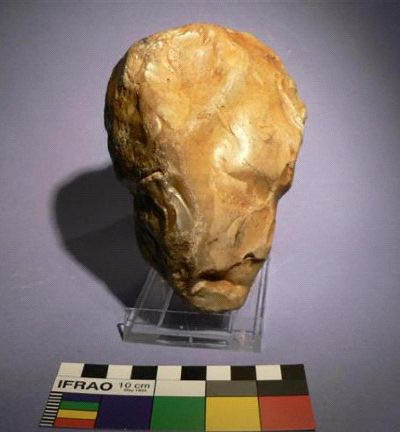
In her opinion, it ought to be consider, that many of her lithic remnants found, would need to be discussed further and not only judged under the tool type aspect alone.
The village of Gross-Pampau, where she collected the material in a gravel pit, is located in the vicinity East of Hamburg, and closely situated near the small town of SCHWARZENBEK, in SCHLESWIG-HOLSTEIN, Northern - Germany.
This former gravel pit celebrated a 25th anniversary already in 1992. At that time, the old surface ground lowered by 7 meters when entering the site and most of her finds came from the ground water level filling the site gradually. There were professionally drillings done by the Geological Institut KIEL and several whale and shark fossils discovered from the Miocene clay. Mrs. Benekendorff documented some of the geological occurances there and published some of her findings in 1990 (Benekendorff 1990, pp. 14-28).
Her collection consists from thousands of artifacts. It is archaic tools and tool’s preforms. They have a wide variety of different size, design, and hard materials. More than twenty of them are identical to the Acheulian rougher bifaces, cleavers, hammerstones and thick Levallois flake tools from Bajanibhat (Bednarik 2005, V. 22, n.2. p. 185. Fig.48.). More than hundred of handaxes of the Benekendorff collection would allow providing typological analysis of different periods of the Stone Age. At the same time, there are more than fifty different kinds of artifacts with evidences of artificial work.Those artifacts were not shape as handaxes tools; they were not shape as portable art images. Nevertheless, from my point of view, it will be big mistake not to mention such evidences of artificial work on very hard materials (Fig. 1a). It is a separate group of artifacts, which should be considered according to the attention to the context. However, the most attractive part of the findings is, some of the artifacts, I consider as Palaeoart, portable art.
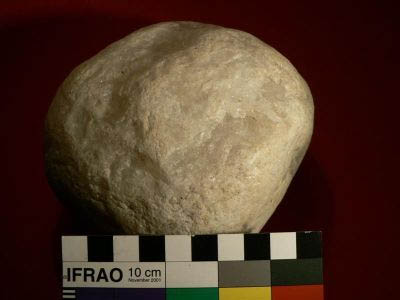
Fig. 1a the evidence of artificial activity on milky quartz artifact Catalog Nr. 490 III, photo U. Benekend.
This artifact group made from the similar spotty type of flint material does include several types of tools completely different from the Acheulian type. They are smaller, lighter and more thinly, approximately 1 – 1,5 cm only, with an elongated, approximately 15 cm. sharp part on one side created by retouching and re-use flaking. The most representative examples of those tool types cataloged under number T-0,056, (Fig.2), T-0,075 (Fig.3) and T-0,095 (Fig 4).
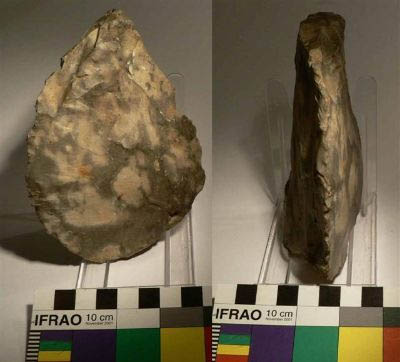 Fig.2
Fig.2
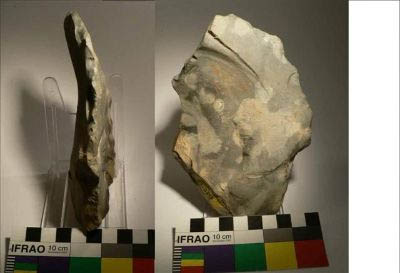 Fig. 3
Fig. 3
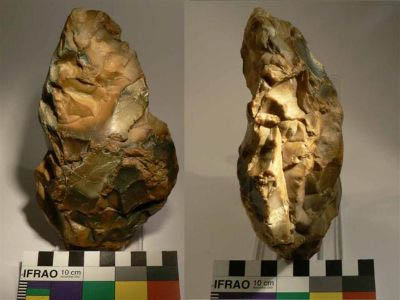 Fig. 4
Fig. 4
Continue with the Lisbon - paper 2006 of Arsen Faradzhev --page- 5
T-0,095 (Fig.4) is considered by me a good example of the highest level of Stone Age peoples’ “possibilities” of handicraft, in having more than 70 very precise and small flint chips in form of “re-use flaking” taken off.
A big difference from this tool type group is a turtle artifact with the catalog number is Tor. - 0,001 made from the same spotty flint material (Fig. 5-8). The longest line of this artifact is 18,5 cm., widest part is 10,5 cm. and the heights one is 8,5 cm. (Fig. 6).
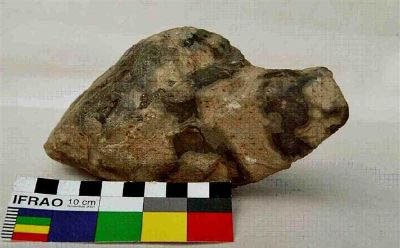 Fig. 5
Fig. 5
There are three obvious exceptions separating the portable art image from any other tool of the collection. The first one is two different ends of this artifact. Therefore, the artifact has unequal parts – a light part and a heavy one (Fig. 5). They looks like an obtuse, wide and heavy end on one side and narrow, long and light end on the opposite side. The heavy part is consisting of two three-dimensional surfaces – the upper and the lower one, united by the perimeter line of 27 cm. in length.
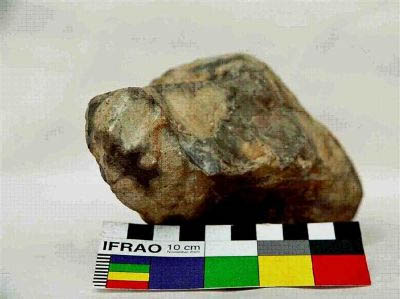 Fig. 6
Fig. 6
The upper surface of artifact heavy part is counting three facets. Two of them are 10,5 cm. long and around 5,5 cm. wide. The third facet on the upper surface is 9 cm. long and only 3 cm. wide. The lower surface consists of three facets as well – two of them are around 15 cm. long and approximately 7 cm. wide and the third one is 9 cm long and 6,5 cm. wide.
Three facets of the lower surface are combining a light part and a heavy one. Two of them are 15,5 cm. long and 7 cm wide. In addition, the third facet, 9 cm. long and 6 cm. wide, is also located at the bottom surface. It is supporting the heavy part as a basis and allows placing the portable artifact into such a position in which the light part will be looking up as well as to the left from the hypothetical central axis (Fig. 6; 7).
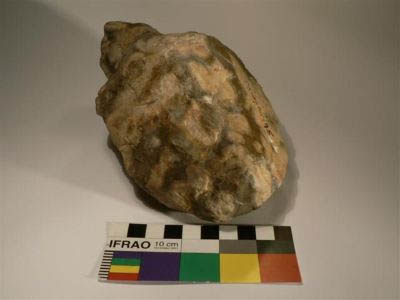 Fig. 7
Fig. 7
The second exception is the location of two hypothetical internal flatness parts standing in perpendicular to each other. Moreover, the third important exception is that the spotty kind of flint material is marking the overall appearance of the portable image.
Therefore, I am considering the artifact of the Benekendorff collection with catalog number Tor-0,001 a Palaeoart portable turtle image (Fig. 7; 8). However, it is not the only portable art image in the collection.
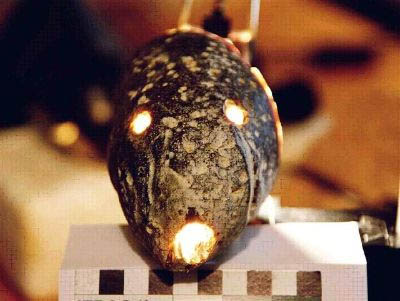 Fig. 8
Fig. 8
The flint stone artifact catalog number is F-0,002 looks like the upper part of a truncated cone 7 cm. in diameter. It is empty inside and therefore it is possible to see that the thickness of the walls are around 1,5 cm. with three natural holes – one at the top of the flint cone, 0,8 X 1,3 cm. wide and two holes are coming from inside to the outside surface. Their outside diameter are just 0,5 cm. wide.
The work under the microscope allows me to see that both of them artificially enlarged from the outside and directed to the front position. More so, they seem enlarged from the outside in a different way. The left hole widened at the entrance till 0,8 X 1,2 cm. And the right one got smashed in the front part of the hole over a distance of 0,9 cm length and 0,7 cm. width. The front hole design from outside all around except the part is 0,4 cm. wide. The longitude of the ellipse is 2,7 cm. and 1,8 cm. wide.
Therefore, I am considering the artifact of the Mrs. Benekendorff collection with catalog number F-0,002 a portable Palaeoart image of the fish head (Fig.8; 9). I would like to mention one more portable art image of the Benekendorff collection.
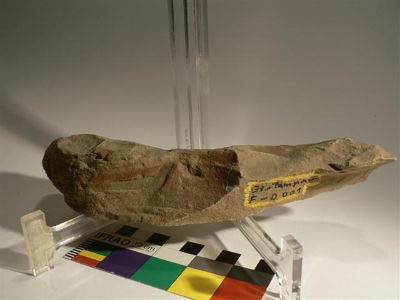 Fig. 9
Fig. 9
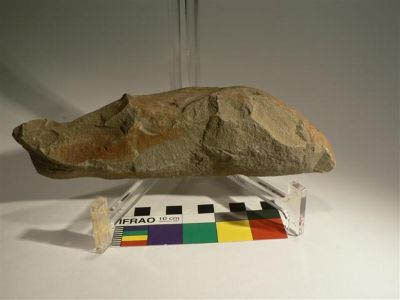
It is metamorphosed sandstone with catalog number F-0,001, 19,5 cm. long, 6 cm. tall and 2,5 cm. wide. It is flat from one side and artificially designed from the other. One end of this stone designed as part of an arch 12 cm. And is from 0,5 to 3 cm. wide. It is around 9,5 cm. along the straight line from the beginning till the end of the arch line. The upper line is designed to create some kind of the slope 10,5 cm long and 4 cm wide from the same end. The red color line is starting at the middle and continues by 8 cm. and 4 cm. to the bottom of the artifact.
There are more than ten flakes along the designed side of this sandstone artifact. Therefore, all those evidences allowed me to consider this artifact as sandstone fish portable image.
Conclusions.
The act of Palaeoart creation is in itself already a unique exception from all other possible kinds of human selections and the Palaeoart research seems to be also a selection process. The researcher prehistory time either coming from some institute or being a private collector selects the images, site, the approach, methods, and evidences and so on. Moreover, for each, it remains an individual selection, often governed by a person private judgment applied towards creation.
Nevertheless, it reflects also a very personal feeling towards art. Again, this is the same for everyone either being an institutional or private researcher and a key point at the same time. It is similar to musical “feeling” and understanding of tunes not always heard with a “perfect ear”. Regardless, the researchers do have to present their “scientific evidences” of their investigation in a proper way and such can be expected in general from the institutional researchers having been trained to present the basis of research (Allakhverdov 2005, p.49), so as if it is some kind of scientifical approach even on a minimum basis.
Here in this particular case the German Institutes and their scientists ignored the importance of a reported fireplace, which can be helpful to obtain direct datings for possible artifacts found in the vicinity. At least assisstance of a specialist should have been accompanying this sampling procedure of layperson, instead simply refusing the overall material. The private collectors are spending many years of handling their stones. However, the experts are coming for few days and other just few hours to see and select something from the collection, which cannot give enough time to see a reasonable minimum part of the stones.
The few examples of portable art artifacts, which I consider in this article, are showing that in a future it could be much more of them. One of them is giving indirect date. The portable image of the turtle is belonging to pre-glacial fauna.
The selection process is a key point concerning the Palaeoart as I try to show in my article, but it is not a Palaeoart images problem. It is a matter of human choice.
Acknowledgments
I am grateful for the invitation to present article at the symposium C26 and particularly grateful to Ursel and Helge Benekendorff for the financial support and great honor to work twice during 2006 with their private collection and for the possibility to participate on the Lisbon Congress 2006. I am deeply grateful to Ursel and Alan Benekendorff for their assistance of writing this article and for flexibility and patience during long and intensive discussing and research of the artifacts of private collection artifacts.
REFERENCES
ALLAKHVERDOV, V., 2005. Splendour and Misery of Empirical Psychology: Towards a Methodological Manifesto of Petersburgian Psychologists, PSYCHOLOGY, the Journal of the Higher School of Economics, pp. 44-65.
BEDNARIK, R., 2003. The earliest evidence of Palaeoart. RAR Vol. 20, Number 2., pp. 89-135.
BEDNARIK, R., Kumar G., Watchman A., Robert R. 2005. Preliminary results of the EPI project. RAR Vol. 22, Number 2., pp. 147-197.
BENEKENDORFF, U., 1990. From the information-recorder “stone” to a “picture book” of the old-stone-age. Archaeologische berichten Nr.20., pp. 14-28.
MATTES W. 1969. Eiszeitkunst im Nordseeraum Niederelbe-Verlag. Otterndorfer Verlagsdruckerei. H. Huster KG. Otterndorf N.E.
FARADJEV, A. 1995b. Rock Art Research. A genesis of approach. In NEWS-95 International Rock Art Congress. Abstracts of Academic Symposia 1A-New approaches, pp. 37-38, Centro Studi e Museo D’Arte Preistorica, Pinerolo, Italy.
FARADJEV, A. 1999b. Metaphysical opportunities as a tool of rock art research. In NEWS95 – INTERNATIONAL ROCK ART CONGRESS, North, East, West, South, 1995 IRAC. PROCEEDINGS, Volume + CD-ROM (Symposium 1A: New approaches, part1, theory – ), IFRAO – INTERNATIONAL FEDERATION OF ROCK ART ORGANIZATIONS, pp.46, PINEROLO, ITALY.
report ====================news====================26. April 2008
Dear Ursel,
Let me share with you some information to keep you informed.
To: Frankford Museum Society
From: Dr. Arsen Faradzhev
Date: April 17, 2008
Topic: Report on Activities (April 1 – April 17, 2008)
The itinerary includes several items of interest. To combine the FMS collection from different individuals and locations to one location; to work on the Lost Valley Site and to select artifacts for presentation to professional scientists. Trips were taken to the Gault Site near Austin, Texas and a trip to Natural History Museum of the Smithsonian Institute in Washington, DC and finally to try to rehabilitate the focus of Lost Valley scientifically.
After the arrival and with the help of Ed Owens, who picked me up at the JFK airport in New York, we began working at the site the day after arrival. I would like to say thanks Jeff Kottmyer who prepared and had everything ready as planned. The work on the stream showed us plenty of preforms, which were very similar to those previously collected and in the storage area. They could be quite curious and unusual, but after the cleaning, it was obvious that they were wild (natural) rocks. During four days of work, we collected five artifacts from several thousand rocks that were examined at the site. Most unusual among the five was the mammal tooth with patina, but identification of this artifact is the field of a specialist in osteology as to its origin.
It was great support on behalf of John and Barb Stokes plus Ed Owens to get the artifacts from Gary Yannone. I am very appreciative of their help and am sure that without it, we would not have been successful. We started with his not wanting hear from us or to see us to having communication and being able to secure the collection after my departure.
I am grateful to Dennis Hurley for bringing the artifacts from Bosler Library. From the selection, we got a collection of portable rock art and tools to take to the professional scientists. Thanks to Ed Owens who purchased two display boxes for transporting artifacts. Thanks as well to Dennis Hurley who provided transportation to BWI on Friday morning and the return trip on Sunday afternoon. Thanks to Jeff Kottmyer, Ed Owens, and other members of Frankford Museum Society for the brilliant organization for the trip to Austin, Texas.
The trip to Austin includes two parts: (1) the visit to the research laboratory on Friday, April 11th and (2) the Gault Site on Saturday, April 12th. Ed Owens rented a car and accompanied me to the University of Texas archeological research lab. We met two specialists, Dr. D. Clark Wernecke and Dr. Andy Hemmings. Unfortunately the primary investigator, Dr. Michael Collins was unavailable for the Friday afternoon, because of need at the site. Dr. D. Clark Wernecke, project director, and Dr. Andy Hemmings spent more than three hours with us at the laboratory. It was very important to know that the opinion of the specialist in tools (Dr. Hemmings) was very concerned that some of the tools and artifacts were lacquered. Also they told us about their work and explained about the unique device that enabled them to see the utmost details of engraving on the stones. This work was performed at Mercyhurst College, Mercyhurst, Pennsylvania under the guidance of Dr. James Adovasio. They asked us a lot of questions and ninety-nine percent of them were about context. When it was impossible to keep silent, the response was we do not know. Dr. Hemmings also asked detailed questions concerning the geology of the site. Both he and Clark suggested FMS should accomplish this before any other endeavor.
We (Ed, Jeff Kottmyer and myself) arrived at the Gault Site at 11:00 AM on Saturday, April 12th. The principle investigator of the site, Dr. Michael Collins, was very kind to give us his time to personally show the site and explain the most important problems and aspects of the site. For my mind, it is important to know that this site is recognized in the United States for its portable art artifacts. These artifacts are quite unusual. They are composed of limestone pieces approximately 50 centimeters in length and are engraved in a different way by the flint tools. The researchers have collected over a thousand of these pieces from areas with the 16 ha. Only a few have been thoroughly investigated in the laboratory. The very clear stratigraphy (cultural layers) allowed asking Dr. Collins about the location of the incised artifacts. He answered that they are from 13,000 before present (bp) and 7,000 bp. It means that the tradition to create such engraved portable artifacts existed approximately 5,000 years which is longer than all historical period of modern world (4500 years). As usual there is no information for the why’s; started, existed, and stopped. Another curious thing that they know what they are looking for, paleo fireplaces, but there is no evidence to this point. Dr. Wernecke has uncovered a stone platform that alludes to a possible hearth. These hearths seemed to be lined with limestone and there is much evidence of fire-cracked limestone throughout the Gault Site. At the same time it is important to say that the stream (Buttermilk Run) reminds me of the Lost Valley stream. It looks like a flat area now, but need to take in account that in the first part of the twentieth century (1929) it was two meters higher than today. The reduction is due to compaction and early excavation by renting the site for $25 a day by the previous landowners. I have to mention the field facilities are quite tough and I will never forget fire ants. Never the less, the Gault site averages over 4000 volunteers per year. We returned Sunday, April 13th, and again appreciate the help of Dennis Hurley who picked us up at BWI.
The next day, Monday, April 14th, Ed Owens, Dennis Hurley, and myself visited Dr. Dennis Stanford at the Natural History Museum of the Smithsonian Institute. We brought the collection artifacts and tools to his laboratory, and I appreciate very much his attention to the Lost Valley story. He was very attentive when looking through the artifacts and tools, and as in the previous discussion of Gault, asked about context. Dr. Stanford was not against the possibly of recognition of the Lost Valley site. At the same time he asked to be kept informed of news about Lost Valley. We were very pleased to be shown the Smithsonian artifacts. After showing us the artifacts, which include the oldest known paleo artifact in the United States, he decided to show us power point presentations (3) pertaining to Clovis similarities of Europe and the United States. There are now evidences of many paleo sites in the territory of United States with dates greater than 20,000 yrs bp with strong contextual evidence. Let me use this opportunity to express my gratitude to Ed Owens for providing the transportation to Washington and back.
Finally I would like to thank very much Gary Yannone who decided to store his collection of artifacts with all of the others. He confirmed this by signing the official document of the Frankford Museum Society, and Ed will bring them to the storage shed at a later time. During my meeting with Gary on April 16th, I understood that he continues to think about the Lost Valley. Gary listened to my information about the history of the Gault Site, which was discovered in 1929, very attentively, and he would like to continue research at the site. Gary mentioned that he would like to work with Ed, Jeff, and myself doing work for Lost Valley, and I think this is very important. He was very disappointed about the news from Josh Kerr (Josh said he no longer wants us to work at the site.) This meeting was made possible with the help of Ed Owens, John and Barb Stokes.
Conclusions:
The Gault Site delivered engraved limestone artifacts, which are recognized as variants of portable paleo art. There should be a huge amount of work in the laboratory with these artifacts. At this time there are no figurines of artwork, only abstract lines that resemble, in some cases, plants. There is some mention of animals, but we did not see them at this time. On the other hand, the Lost Valley site, which has no context, already delivered outstanding portable art, figurines with amazing feeling of the material. Dr. Stanford agreed that this is possible as well. During the return trip from the Gault site, it was suggested that I send to Dr. Collins pictures of the flint portable art from Moscow. This could help in their identification process with the volunteers. I do believe that it is a great idea of Ed Owens and Jeff Kottmyer to pass the Gault training and then to partake in a Gault investigation. This experience would then be used with the Lost Valley site in future exploration.
I am very grateful to all members of the FMS for their great help during my visit. In particular, I would like to thank Sandy and Ed Owens for their patience that kept me with my non-pleasant personality. (:
Sincerely Yours,
Arsen Faradzhev, PhD. Month of April 2008
"PALAEO-ARTA", NEW ARTICLE AND IMPRESSIONS BY ARSEN FARADZHEV; MOSKAU , Russia 26th of June 2008
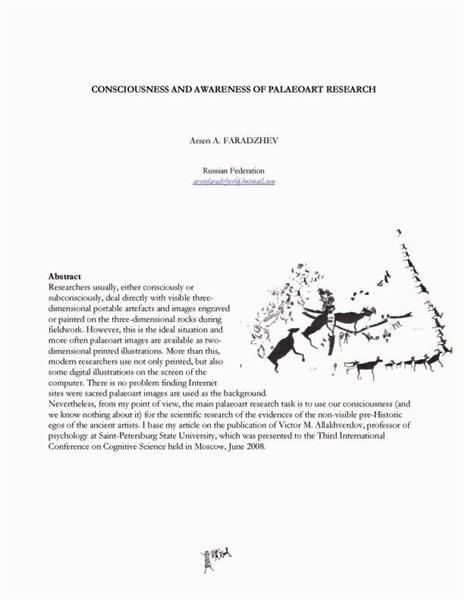
Dieser Aufsatz liegt hier vor und kann bei Interesse angefordert werden.
The essay is available up on demand here.-- see my email front page of this site.
Austellung im Darwin-Museum MOSKAU (HÖHLENKUNST)
Exhibition took place on July 15th -Aug. 22nd 2010 in DARWIN-MUSEUM; MOSKAU ( CAVE-ART)
ARSEN FARADZHEV IN FLAGSTAFF ;ARIZONA USA
Motel Super 8 at Flagstaff
OLYMPIC MOUNTS OF FLAGSTAFF...an elevation of 2.500 m presented not always nice weather.
GETTING READY
VERY RELIABLE VEHICLE: rented a Wrangler jeep and had no problems during 3.300km driving in two weeks.

On the way to Gordon Panel 2.
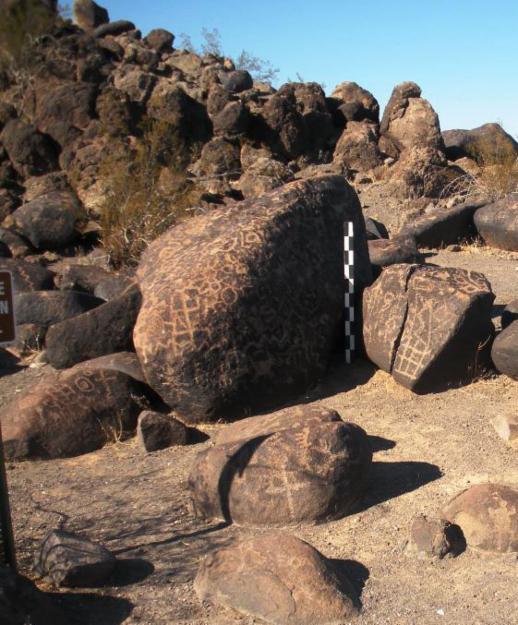
The general view of the site.
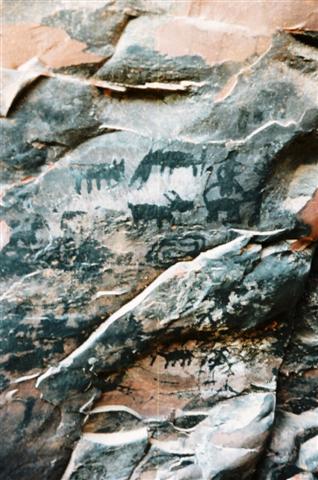
Pictograms in the Palatki-shelter, a very rare "black on black" type of Rock-art-images at the shelter.
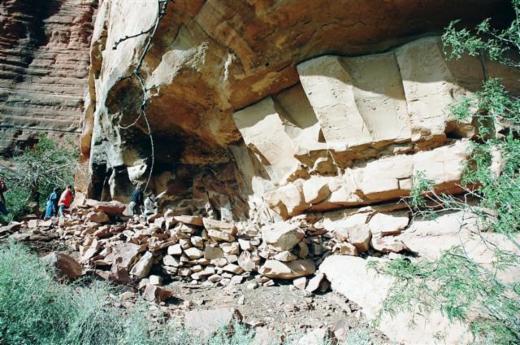
The left part of the Palatki-shelter
MAIN VIEW OF THE PANEL
FIRST HALF OF THE LEFT PART
LAST HALF OF THE LEFT PART
RIGHT PART OF THE V BAR V PANEL